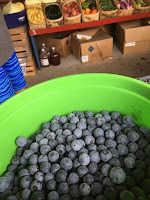Vivian Sun :: Week 6 :: The Grand Finale

Week 6 was my final week! The time went by faster than I ever could have imagined - six weeks seemed a daunting stretch of time at first, but I realized how short it really was as I started my sixth week at JHU. I wrote up and finished my bone marrow monocyte isolation protocol over the weekend and began my final week by going over the protocol with Snow. I got a clearer sense of what we would be doing, why we were doing each step, and what the overall purpose of the experiment; she answered all of my lingering questions and provided helpful tips for me to keep in mind in anticipation of and in preparation for the experiment. For clarification purposes, my new protocol was called "Bone marrow monocyte enrichment using the Miltenyi bone marrow monocyte isolation kit" (Miltenyi is the name of the company that makes the enrichment/isolation kits). We wanted to look at how many monocytes could be obtained from the bone marrow, as well as test out the aforementioned Miltenyi k


